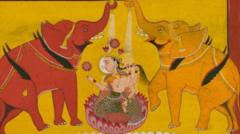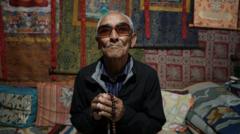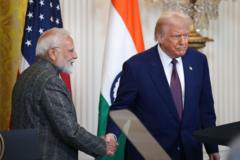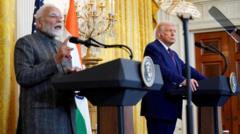The new exhibition at the British Museum, "Ancient India: Living Traditions," features a diverse collection of 189 artifacts that explore the transformation of spiritual representation in Indian art from 200 BC to 600 AD. It highlights the continuous dialogue among the traditions of Hinduism, Buddhism, and Jainism, offering insights into their shared heritage and unique artistic expressions.
Unveiling India's Spiritual Legacy: A New Exhibit at the British Museum

Unveiling India's Spiritual Legacy: A New Exhibit at the British Museum
The British Museum presents "Ancient India: Living Traditions," showcasing 189 artifacts that highlight the evolution of spiritual art across Hinduism, Buddhism, and Jainism.
The British Museum in London has opened a captivating new exhibition titled "Ancient India: Living Traditions," which offers an in-depth look at the rich history of spiritual art from the Indian subcontinent. Featuring 189 carefully curated artifacts, the exhibit spans centuries, allowing visitors to encounter a stunning array of sculptures, paintings, narrative panels, and manuscripts that represent the evolution of religious expression in India.
The transformation of art associated with Hinduism, Buddhism, and Jainism is at the heart of this exhibition, particularly the period between 200 BC and 600 AD. During this significant era, the artistic portrayal of divine figures began to shift from abstract symbols to more identifiable human representations. "Today we cannot imagine the veneration of Hindu, Jain or Buddhist divine spirits or deities without a human form," explains Sushma Jansari, the exhibition's curator, emphasizing the importance of this transition.
Visitors can explore a framework divided into five thematic sections, beginning with the nature spirits and continuing through subsections dedicated to each of the three religions. The exhibition concludes by highlighting the dissemination of these faiths and their artistic traditions to regions beyond India, including Cambodia and China.
Notably, a striking two-sided sandstone panel featuring the evolution of the Buddha serves as the centerpiece for the Buddhist art collection. One side, carved around AD 250, depicts the Buddha in human form, adorned with elaborate details, while the other side, dating back to around 50-1 BC, presents a more symbolic representation featuring a tree, an empty throne, and footprints, illustrating a critical moment in Buddhist artistic history.
In the Hindu section, an early bronze statue represents another transformative period in sacred imagery. The figure resembles a yakshi, a powerful nature spirit embodying fertility and abundance, but it also incorporates defining features of later Hindu female deities. Jain religious art is also showcased, with works highlighting the 24 enlightened teachers known as tirthankaras, marked with a sacred symbol that dates back roughly 2,000 years.
What makes this exhibition particularly unique is its holistic approach, featuring all three religious traditions in tandem rather than in isolation. It also thoughtfully addresses the provenance of each item, providing insight into their journeys through various collections. Jansari notes that many of the patrons who donated Buddhist art were women, a detail that adds another layer to the understanding of the art's history.
Despite its deep dives into the artistic evolution, the exhibit leaves some questions unanswered, particularly regarding the factors that prompted this shift in visual language. "That remains a million-dollar question. Scholars are still debating this," states Jansari, acknowledging the ongoing curiosity surrounding these transformations.
The exhibition also provides a multi-sensory experience with carefully curated scents, textures, and sounds, designed to encapsulate the atmosphere found in active Hindu, Buddhist, and Jain shrines. Jansari collaborated with various artists and community partners to create an inviting and immersive environment that evokes the serenity of these sacred spaces.
Moreover, the exhibit features short films showcasing practicing worshipers from each religion in contemporary Britain, reinforcing the notion that this exhibition is not solely a reflection on ancient art but a celebration of living traditions that continue to resonate with millions around the globe.
Running from May 22 to October 19, "Ancient India: Living Traditions" promises not only to educate but also to inspire visitors to reflect on the profound interplay between faith, culture, and art throughout history.






















